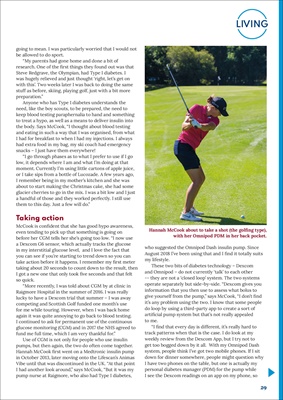
29
LIVING
going to mean. I was particularly worried that I would not
be allowed to do sport.
"My parents had gone home and done a bit of
research. One of the first things they found out was that
Steve Redgrave, the Olympian, had Type I diabetes. I
was hugely relieved and just thought 'right, let's get on
with this'. Two weeks later I was back to doing the same
stuff as before, skiing, playing golf, just with a bit more
preparation."
Anyone who has Type 1 diabetes understands the
need, like the boy scouts, to be prepared, the need to
keep blood testing paraphernalia to hand and something
to treat a hypo, as well as a means to deliver insulin into
the body. Says McCook, "I thought about blood testing
and eating in such a way that I was organised, from what
I had for breakfast to when I had my injections. I always
had extra food in my bag, my ski coach had emergency
snacks - I just have them everywhere!
"I go through phases as to what I prefer to use if I go
low, it depends where I am and what I'm doing at that
moment. Currently I'm using little cartons of apple juice,
or I take sips from a bottle of Lucozade. A few years ago,
I remember being in my mother's kitchen and she was
about to start making the Christmas cake, she had some
glacier cherries to go in the mix. I was a bit low and I just
a handful of those and they worked perfectly. I still use
them to this day. Just a few will do."
Taking action
McCook is confident that she has good hypo awareness,
even tending to pick up that something is going on
before her CGM tells her she's going too low. "I now use
a Dexcom G6 sensor, which actually tracks the glucose
in my interstitial glucose level, and I love the fact that
you can see if you're starting to trend down so you can
take action before it happens. I remember my first meter
taking about 20 seconds to count down to the result, then
I got a new one that only took five seconds and that felt
so quick.
"More recently, I was told about CGM by at clinic in
Raigmore Hospital in the summer of 2016. I was really
lucky to have a Dexcom trial that summer - I was away
competing and Scottish Golf funded one month's use
for me while touring. However, when I was back home
again it was quite annoying to go back to blood testing.
I continued to ask for permanent use of the continuous
glucose monitoring (CGM) and in 2017 the NHS agreed to
fund me full time, which I am very thankful for."
Use of CGM is not only for people who use insulin
pumps, but then again, the two do often come together.
Hannah McCook first went on a Medtronic insulin pump
in October 2013, later moving onto the Lifescan's Animas
Vibe until that was discontinued in the UK. "At that point
I had another look around," says McCook, "But it was my
pump nurse at Raigmore, who also had Type I diabetes,
who suggested the Omnipod Dash insulin pump. Since
August 2018 I've been using that and I find it totally suits
my lifestyle.
These two bits of diabetes technology - Dexcom
and Omnipod - do not currently 'talk' to each other --
they are not a 'closed loop' system. They two systems
operate separately but side-by-side. "Dexcom gives you
information that you then use to assess what bolus to
give yourself from the pump," says McCook, "I don't find
it's any problem using the two. I know that some people
do loop by using a third-party app to create a sort of
artificial pump system but that's not really appealed
to me.
"I find that every day is different, it's really hard to
track patterns when that is the case. I do look at my
weekly review from the Dexcom App, but I try not to
get too bogged down by it all. With my Omnipod Dash
system, people think I've got two mobile phones. If I sit
down for dinner somewhere, people might question why
I have two phones on the table, but one is actually my
personal diabetes manager (PDM) for the pump while
I see the Dexcom readings on an app on my phone, so
Hannah McCook about to hit the ball.